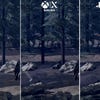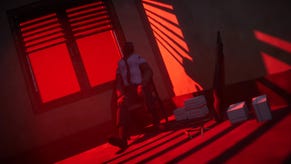Armored Core 6: a brilliant game with the standard From performance issues
Big tech improvements for PC users though.
After an 11 year absence, the Armored Core series jet-boosts back into action with Armored Core 6: Fires of Rubicon. And, given the huge success of Elden Ring last year, there is now of course heightened interest in developer From Software's output, regardless of what form it takes. Armored Core 6 is a completely different beast in game design to the studio's more recognised series of course, and so the question is this: has the technology evolved to a sufficient degree that the game overcomes the technical issues we saw with Elden Ring?
The truth is that despite its different, mission-based game structure, Armored Core 6 does still share its technical DNA with Elden Ring, in that it uses the same engine. Based on Tweets from modder Lance McDonald, it's the same From Software technology, though put to work on a wildly different concept. The high fantasy, seamlessly traversable world of Elden Ring - its knights and magic - are replaced by bleak, futuristic areas, often segmented by the mission. We get giant warring mechs, thundering across its world at breakneck speed. We get explosive battles, going from tanks in the city to a colossal, weaponised mining ship. The sense of scale is often awe-inspiring, but can the technology handle it?
Let's kick off then with the graphics modes. There are three choices on PS5, Series X and Series S - and they work similarly to Elden Ring. Taking PS5 as an example, frame-rate mode and quality mode differ mainly in resolution. The quality mode runs at a fixed 3840x2160 resolution, even with big frame-rate drops, backed by a form of temporal anti-aliasing. However the frame-rate mode is a more sensible pick all round, in that it dynamically adjusts image quality based on how near or far it is from 60fps. So, at maximum it targets 4K in simpler scenes, and then its lower bound comes in at 2688x1512 - the same as Elden Ring. If the frame-rate is still going below 60fps with the resolution bottoming out at 1512p, the game doesn't adjust any further and the frame-rate drops become greater.
All of this applies to Series X of course. And straight up, I'd be looking to use the frame-rate mode from the moment you boot the game, simply because holding 60fps makes such a difference to the feel of Armored Core 6's gameplay. That said, the frame-rate mode is slightly simplified: you'll notice environmental shadows take a hit in quality compared to quality mode. This is the most significant drawback honestly. It's not pretty, and to be clear it only affects world shadows - not the shadows from your mech, which remain sharp. Also, it's worth noting this shadow quality setting is dynamic in nature while using the frame-rate mode - in much the same way as the resolution is dynamic. So, for example, if we drop the rendering load by looking straight at the ground in frame-rate mode, the shadow quality boosts to a higher preset. Give it a second, and it matches the quality mode shadows, and yes the overall resolution switches to 4K. Inevitably, looking back up to see the environment in all its complexity, the GPU rendering load spikes sharply. The frame-rate then tumbles as a result, below 60fps, and to restore PS5 and Series X to 60fps the shadows fall back to a pixellated, lower setting.
It's a clever system. Unfortunately, these settings changes - the dynamic resolution and shadows - do take a few seconds to kick in, meaning you'll still often see performance drops. Either way it's the best mode we have and worth the tradeoff to get closer to 60fps. Otherwise, geometry and foliage draw, texture resolution and the shadows from mechs themselves are all a match between these two particular options. The only other discrepancy is in screen-space reflection quality - SSR - which appears marginally higher resolution on quality mode. Also, one final point: Armored Core 6's cutscenes run at the same resolution and visual settings, regardless of mode chosen. Or in other words: in-engine cut-scenes switch to quality mode regardless of how it's set in the menus, and render at 4K.
With all of this in mind, there is one final option to try: the ray tracing mode. This is common to all current-gen consoles, though only engages with the quality mode selected. Unfortunately, it also only affects the garage portion - a small hangar where your mech is stored, essentiallyl, which is quite unlike Elden Ring where RT ambient occlusion and RT shadows actually engaged in gameplay itself. The application of ray tracing here is simply rather limited. Even in comparison, the before and after is subtle: the mech's metal chassis benefits from ray traced ambient occlusion - enhancing the shading in every corner. There's potentially RT shadows too, far below the deck, though this is much harder to catch. In summary, the use of ray tracing isn't a radical one - though From Software does at least include a photo mode to capture the details of your mech with it enabled.
The turnout of the three modes across the three consoles is straightforward. We've already talked about the quality and performance modes and these are a complete match between Series X and PlayStation 5. More interesting though is the Series S situation. In quality mode on Series S, the resolution is a fixed 1440p, while if we swap to its frame-rate mode, this becomes a dynamic 1440p instead, scaling down to 1792x1008 at lowest. Expectedly, shadows use the same dynamic system in frame-rate mode as PS5 and Series X, too. Though, it's worth noting Series S still runs at lower visual settings generally compared to the more powerful machines. The shadows - even in the best-case - are of a lower quality than PS5 and Series X, while texture quality, shadow draw distance and geometry are also dialled back, resulting in slightly more pop-in for select elements. Series S does hold up well visually in general, but it does make concessions to preserve its frame-rate.
All of which leads us to the key topic of performance, where Armored Core 6 runs with an unlocked frame-rate in both quality and frame-rate modes - but with an at times loose grasp on the target 60fps. Looking at quality mode, potentially there's scope for PS5 or Series X to hit the top 60fps line by looking directly up at the sky - but that's all. Sadly, the fixed 4K resolution on each console, the higher-grade shadows, drag the frame-rate into the 30-45fps region during any real action. The game runs at its best around the opening hangar area, closer to the 45fps lin, but the net result is that even a VRR-supporting display will struggle to hide the perceptible judder from sub-40 drops. Worse still, the game is also prone to lurches into the high-20s. I've barely scratched the surface of Armored Core 6's huge campaign - but the climax of the Strider battle has a huge sub-30fps stress point on both PS5 and Series X.
Frame-rate mode on PS5 and Series X is much better but not perfect meanwhile. It has issues holding 60fps in every mission, but I will say it gets there more frequently than Elden Ring's own frame-rate mode. For both premium machines there are long chunks of gameplay - especially across chapter one, resting right at the top 60fps line. It's usually only punctuated with drops to the 50s by sudden camera movements owing to the laggy DRS solution. This happens across the board on PS5 and Series X, as new effects, and new portions of the map reveal themselves. In theory, simply fixing the resolution to the lower bounds figure of 1512p would likely have evened out most of these drops on either machine. Yes it's nice to briefly run at higher resolutions - at 4K - where it's afforded by their GPU power - but consistency at 60fps would have been worth so much more. In the end, what we're left with is a variable 50-60fps readout on PS5 and Series X.
There is good news though, in that PS5 users have 'one weird trick' that opens access to get a far more consistent experience. Simply put: download and play the PS4 Pro version of the game, running it under backwards compatibility. Across the first six missions, this gets us the smoothest 60fps readout, with barely a dip before most mission's end. There is a catch though, obviously, in that it's running at a lower resolution and settings than the PS5 app. Being the PS4 Pro settings, in fact, the game's targeting 1800p via checkerboard rendering. In practical terms, this renders a 1600x1800 resolution frame, reconstructed to create a 3200x1800 end result. There are the expected CBR artefacts, too - a kind of stippling effect on edges, though From Software's anti-aliasing technique usually does a decent job of hiding them. And in comparison with PS5 running in the frame-rate mode, the PS4 Pro app holds up surprisingly well. Expect sub-pixel elements - like trees, or the detail-rich metal scaffolds here - to break up. Looking closer, you'll clearly see more noise, but beyond that the detail holds up well.
So is this truly the best way to play Armored Core 6, supposing you only have a PS5? Should you buy the PS4 version? Well, it's not a bad call if your absolute top priority is 60fps. Still, there are some negatives to point out before you jump in. Firstly, the settings are lowered, even below the Series S setup. Switching between PS4 and PS5 versions, texture quality is reduced across the ground, along with texture filtering, resulting in blurrier surfaces. There are also reductions in quality to tree shading quality and reduced geometry draw distances - again, similar to what we saw with Elden Ring running on PS5 using with PS4 Pro code. Pair that with the 1800p checkerboarding, and the image lacks the definition of the genuine PS5 version in quality mode. But in action, I'd say it still holds up. In fact, surprisingly the shadow quality on the floor is a match for the PS5 settings in its frame-rate mode, and even screen-space reflections are retained in puddles for this version.
Another curious trade-off is that the PS4 app removes camera motion blur entirely, which might be a preferece for some. All of this results in the best playing console version, if you have a PS5. Though be warned it isn't entirely immune to drops, so while the action is noticeably smoother across the breadth of chapter one, don't expect this to be a magic bullet to 60fps during the taxing Strider mission. The only other snag is, supposing you've already started on PS5, you cannot convert your saves between versions, and you'll have to start a new game.
Last up, there are few surprises with Xbox Series S. In summary, we're often at 45-60fps in its frame-rate mode, usually veering towards the upper end. Still, the typical readout is lower than PS5 and Series X in the equivalent mode on average, and Series S pushes a less stable 60fps experience as a result. Despite the drop to a dynamic 1440p and the pared back shadow settings, it's more prone to inconsistent performance. Series S has an even tougher time in its quality mode. At a fixed 1440p, it's often just above 30fps in regular action. Call it the mid-30s, dropping into the 20s in the most intense missions. In short, stick to the frame-rate mode here: but don't expect a solid 60fps lock either way.
That covers the state of Armored Core 6: Fires of Rubicon on current-gen consoles. It's not a perfect turnout in terms of hitting 60fps. There are a lot of twists and turns, depending on which mode - or version - of the game you use. What's clear though is, if you want the best 60fps experience, running the PS4 app on a PS5 stands to be a viable workaround. The visual cutbacks run deeper, with a resolution drop, plus pruned back shadows and draw distances but its tighter lock at 60fps services the action well. Otherwise, the frame-rate modes on PS5 and Series X are the next-best options, and worth the trade-offs next to their quality mode. And meanwhile Series S trails the pack, where more regular sub-60fps drops have to be accepted in either mode.
To speak briefly on PC - and while it's not covered in the main video - based on John's reaction, it seems that From Software may finally be taking the platform more seriously. For a start there's support for frame-rates above 60fps (a first for the studio) along with ultrawide and HDR support, and reports of no stutter. It's just a shame that the RT effects being limited to the garage only remain in place on PC when the hardware is there to run them with ease throughout play. So, overall, while it's a touch disappointing that PS5 and Series X performance isn't 100 per cent robust in their native apps, it does seem that PC has receives welcome upgrades this time round. Whichever way you slice it though - and pushing the frame-rate issues aside - this is an exceptional game.












.jpg?width=291&height=164&fit=crop&quality=80&format=jpg&auto=webp)

.jpg?width=291&height=164&fit=crop&quality=80&format=jpg&auto=webp)

